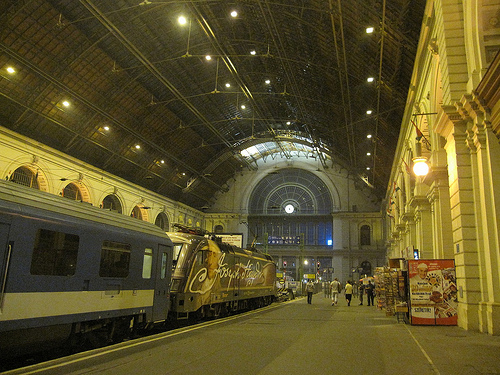
3 May. Bistritz.–Left Munich at 8:35 P.M., on 1st May, arriving at Vienna early next morning; should have arrived at 6:46, but train was an hour late. Buda-Pesth seems a wonderful place, from the glimpse which I got of it from the train and the little I could walk through the streets. I feared to go very far from the station, as we had arrived late and would start as near the correct time as possible. The impression I had was that we were leaving the West and entering the East; the most western of splendid bridges over the Danube, which is here of noble width and depth, took us among the traditions of Turkish rule.
Bram Stoker’s opening words in Dracula
The day had started warm, but as my train left Vienna and approached Budapest, the sky grew somber, and a damp October chill filled the evening air. I was looking for the Count. But not exactly the Count you may be thinking of. He spelled his name differently here, Drakula, and that was the point. I was looking for a native son.
It was 1994, and in this part of Hungary, the echoes of the fall of the Berlin wall seven years before were still reverberating. While travel restrictions around the country had been lifted, the detritus of a hopelessly outmoded Soviet bureaucracy largely remained in place. Deserted guard boxes were scattered around train stations, which still displayed pictures of long dead Soviet leaders. The effect was a surreal landscape in which you found yourself in what was, in effect, a giant prison patrolled by invisible and indifferent guards.
The train drew closer to Budapest. As I pulled my coat tighter around me, the compartment door opened and a man stumbled in, more from his own motion than the rumble of the tracks. His face was lined with a thousand old pains but his eyes were clear and he looked at me with the look you are not supposed to give strangers. He then spoke to me—it was a question because of the raised tone at the end of his sentence—but I was absolutely deaf to its meaning.
Opening up my guidebook section to Hungarian phrases, I responded with comments such as, “Nem értem.” (I am sorry…and then, I don’t speak Hungarian). The stranger apparently took my mutterings as a challenge, he came over to my seat, and leaning down, inches from my face repeated his question. The alcohol from his breath rolled over me in waves. I looked down at the guidebook, clearly inadequate for this task, and decided to just try every answer with the hope that one would work. “Hello, goodbye, nice day…”
Finally the man’s face lightened and a thin smile crept over his lips. He pointed at me, and muttered “Anglish.” He nodded as if he had solved a deep mystery, then rose and left for the door. He turned back to me one last time, yelled “Anglish,” laughed, and was gone.
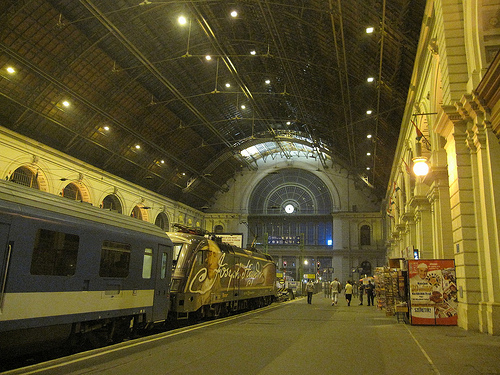 With this introduction the train rolled into Budapest. I pulled my luggage off the train and started for the end of the tracks. I was greeted by the Bathorys, Erzebet and her husband, who had arranged to meet me at the station. We packed into a small car, and sped off to a hotel, plotting our campaign.
With this introduction the train rolled into Budapest. I pulled my luggage off the train and started for the end of the tracks. I was greeted by the Bathorys, Erzebet and her husband, who had arranged to meet me at the station. We packed into a small car, and sped off to a hotel, plotting our campaign.
The problem was simple: the Count was missing. This Drakula, was the name of a character from a Hungarian film, The Death of Drakula, made in 1921. Out of the hundreds of Hungarian silent films made between 1910 and 1930, at the time of my visit in the mid-nineties, only about eighteen complete films had been found. The rest had been destroyed or lost. The Hungarians are not alone in this tragedy. Silent films have shared the same fate all over the world. There are many reasons for these losses: accidents, war, and even intentional destruction. George Orwell said, “Those who control the present, control the past. And those who control the past control the future.” Our history and culture reflect not only the artistic achievements of the past, but also the whims and tastes of passing ideologies. Memory and history are preserved by delicate and often perishable means. In the struggle for control of who will be arbitrator of what is important in this world, vast stretches of cultural history can vanish forever, casualties of this war over what is remembered and what is forgotten.
As time has passed, films like The Death of Drakula continue to be lost, although for the last half century the reasons for their destruction have become consolidated into two overriding problems—time and money. Who will pay and work for their preservation? Dedicated enthusiasts from many different countries have taken up this challenge. Erzebet is such a person. Employed by the Hungarian film board in Budapest, one of her jobs is to be on the lookout for old films. One has to remember without the magic of a projector, these films are essentially of no value except for the their silver content. Their creators long since dead, these old films are like orphans, often victims of neglect and apathy. They were stashed, ditched, or thrown away. In their rusting cans these films are hidden in closets, attics, basements, barns. To do her job, Erzebet needs to be detective, antique collector, historian, and above all, very persistent.
The Hungarian film The Death of Drakula was screened for the general public in 1921. Like most of the films of its era, the film seems to have faded from attention almost as soon as it was made, although the reference sources suggested that a version of the film might have resurfaced for additional screenings in 1923. No records regarding the film other than the title were to be found in any available reference source. The Internet was still in its infancy in the early 1990s, and my visit to Budapest was to investigate primary sources only available in Hungary.
Erzebet and her husband took me to supper. The couple looked like they were going to simultaneously explode, and finally Erzebet asked me if she could smoke. The hands were going for the cigarettes before my nod was finished on my face, and I was amused at this display of politeness where I was the only person in the restaurant not smoking.
The next morning I met Erzebet at the Hungarian Film Institute. I spent the morning in their library, and was able to learn some useful information about my Count. Although of course the film itself was nowhere to be found, we did find records of its production staff and cast. According to the information in the archives, Drakula was directed by Károly Lajthay, a prolific Hungarian filmmaker, who lived from 1885 to1945. His credits list at least thirty films, including The Death of Drakula made in 1921. None of Lajthay’s silent films are known to have survived. There was also an Austrian connection to this film. Erzebet explained to me that German-Hungarian co-productions were quite common at the time. Hungarian crews would travel to Berlin or Vienna to use the studios and available equipment. The cast included a Hungarian, Margit Lux (from her photos available at the archive, she was a Julia Roberts of her day), and two Germans—Paul Askonas, and Karl Jotz. The rest of the cast and crew were Hungarians. A central question remained. Was The Death of Drakula a film about Bram Stoker’s Drakula or perhaps the historical Romanian Count? In this the archives were no help. Across one record was a handwritten note that offered the faintest description of the story. The note mentioned the crew, then stated ‘scenario by H. G. Wells?’ I threw up my hands to Erzebet, who studied the marginal note and responded “The man who wrote that was by trade a lawyer. He came over in his spare time to help collect information. He was dedicated, but he was still an amateur.”
While the archives had no more information, I did learn that records of the intertitles might still be in Berlin or Vienna. With this information, I might still be able to find out the film’s plot. Another possibility was that references to the film could be found at the National Library in another part of Budapest. I could do no more at the Hungarian film archives, so Erzebet and I left to go to the city center.
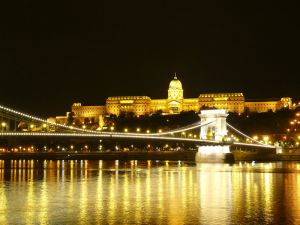 The two towns, Buda and Pest are commonly joined in speech but in life they are separated by the famous Danube River. I found the city beautiful but odd in several respects—running your gaze over the old and beautiful horizon, one’s eye was rudely jarred by more recent buildings (built during the Soviet occupation), that were completely at odds with their surroundings. With these new buildings spread out as random grey dabs of concrete, Budapest looked like a beautiful city that had been shat on by a giant pigeon. These physical monuments of the Soviet presence were impossible to ignore. They must function as both physical and mental irritant to the Hungarian psyche, I thought, a log in a mental eye that one cannot remove.
The two towns, Buda and Pest are commonly joined in speech but in life they are separated by the famous Danube River. I found the city beautiful but odd in several respects—running your gaze over the old and beautiful horizon, one’s eye was rudely jarred by more recent buildings (built during the Soviet occupation), that were completely at odds with their surroundings. With these new buildings spread out as random grey dabs of concrete, Budapest looked like a beautiful city that had been shat on by a giant pigeon. These physical monuments of the Soviet presence were impossible to ignore. They must function as both physical and mental irritant to the Hungarian psyche, I thought, a log in a mental eye that one cannot remove.
Erzebet and I arrived at the town center, and we met her daughter, Ursula, who was to take me around the town. Ursula was a serious twenty-four year old—her serious brown hair was pulled straight back, she wore a serious jean jacket, and her feet were in serious-looking granny shoes. Erzebet left me contemplating her daughter’s stern view of the world and returned to work.

This looks like the coffee shop where we had our drink, but the Internet says the New York was closed in the year I visited Budapest. Maybe it was partially closed? How easy it is to forget, and how hard it is to remember these details.
Trying to lighten the situation, I persuaded Ursula to go to the New York Coffee House, which my trusty guidebook said was the time honored location for pastries and coffees. She looked at the address and off we went. The New York was an essay in 19th century seedy opulence, and the pastries, like the decor, was too rich for casual consumption. There were only a few scattered German tourists in the restaurant. Near us, a piano player was busy unsyncopating Scott Joplin’s ‘Maple Leaf Rag’ by playing it like a Strauss waltz. The waiters ignored us. We waited. Ursula glowered.
“Is this your first time here?” I asked.
“Yes.”
“Is this going to be your last time here?”
“Yes.”
“Let’s go someplace that you like.”

Not the ‘A’ nightclub but a close proximity
She took me to the ‘A,’ an alternative nightclub, brick walls, dark and smoky. Everyone in Budapest smoked. I hadn’t seen any children smoking, but then I had only been in Budapest for two days. I had long suspected East Europe’s cigarette habit was a grand CIA conspiracy to win the cold war. The U.S. military had kept the Soviets occupied with stories of ABMs and Star Wars satellite lasers. Meanwhile, the real dogs of war, companies like Phillip Morris, had crept in and produced a culture of addicts. At the precise moment of an impending NATO invasion, the WARSAW pact countries would collectively gasp and defenselessly fall blue-faced to the ground.
Not that anyone in the CIA had anything against this part of Europe. When the Eastern Europe was carved up like a turkey among the winners of the WW II, Hungary was just the piece of the wishbone that ended up in the wrong camp. The spoils of a game-board view of the world. I asked Ursula about her feelings about growing up under a communist regime.
“I was forced into taking twelve years of Russian,” she explained to me. “Do you know how much of that twelve years I remember? Nothing. Nothing… No, that’s not quite right. I remember this—(and she quickly rattled off a sentence in Russian). It means ‘Hello comrade, I am well today and everything is going as planned.’ We repeated this sentence endlessly. This is what the communist government was to us. ‘Hello comrade, I am well today.’” She crushed her cigarette and lit another.
Ursula was in the Hungarian film school. She was completing a film about the Hungarian version of the Hell’s Angels, motorcyclists who drive around the country flaunting authority, going where they wish, doing what they want. She and her friends had shot twenty-five hours of videotape following these groups. “The bikers have formed local clubs, which are doing really well,” she explained. “But a lot of older Hungarians don’t like these clubs. They see the bikers as a threat. I am going to do two versions of this biker film,” she added. “One is for television. The other will be for school. It will be longer. I can make it…” she stopped, struggling for a word.
“More personal?” I offered.
“Yes. More personal. It will be my film. For TV you have to explain so much. The public is very scared of these people. But you know, these are really very nice guys. Very independent.”
“Would you like to join a biker’s club?”
“These clubs are not for women. There would be no place for me.”
“You know these guys often settle down, buy a house, raise a family.”
“Yes, sometimes, but I see men who are in their 60s, 70s—they dye their hair, come out on their bikes—it’s great!”
“Does is scare you to think what you’ll be doing when you’re older?”
She looked at me hard, then nervously laughed, “Yes, I think I’ll be a housewife and raise a family.” She knocked the ash off her cigarette. “This idea scares me a lot.”
I went to bed that night thinking of what we choose to remember and what we try to forget, and how often we even have a choice in the matter. Hungary had lost most of its cultural memory of its film history, partially from neglect, but largely from two World Wars raging through its streets. Then afterward, an occupying force had done what it could to impose itself on Hungary by forced education and architecture. And yet its grasp on the Hungarian cultural memory was tenuous at best, and in only a few years after the Soviets had left, the memory of its occupation was already slipping away. One conclusion was clear to me—it’s always easier to forget than to remember.
The next morning I went back to the Hungarian Film Archives to follow up with some research and was rewarded by the discovery of a film journal that gave a brief description of the film. More importantly, the magazine had two photos of the film while in production. The Death of Drakula, for decades just a footnote in musty reference books, had at last been sighted! I made copies of these two precious photos. This was a wonderful development, but there was much more to come!
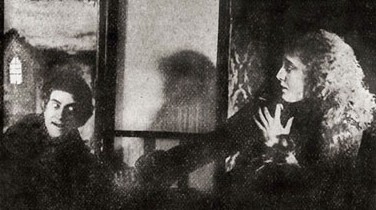
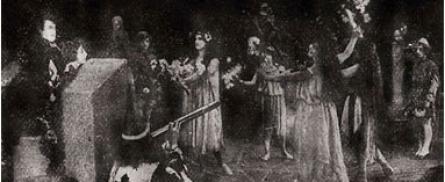
(Next—an interview with an actress that worked with Lajthay, and a Drakula filmbook found!)



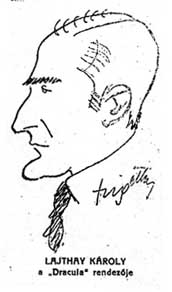
One thought on “Graven Images: Commies, Counts and the Erasure of Memory”
Pingback: R.I.P. Movie: Drakula halála – Dracula’s Dead (1921) | Strabicofilm